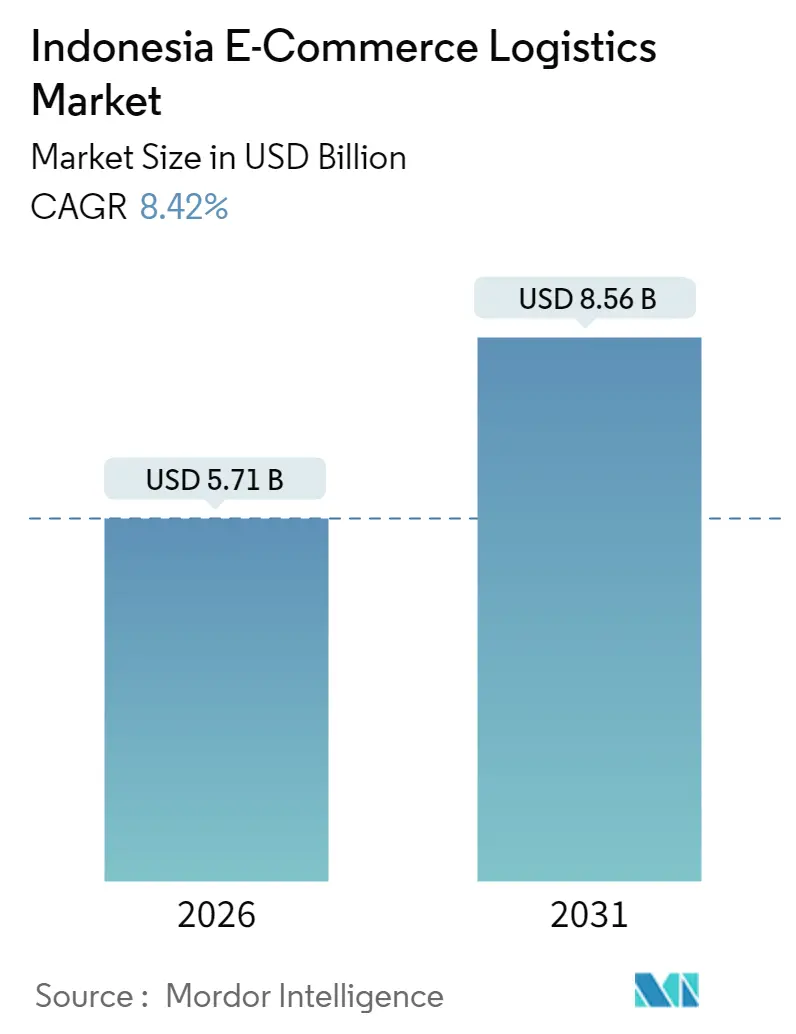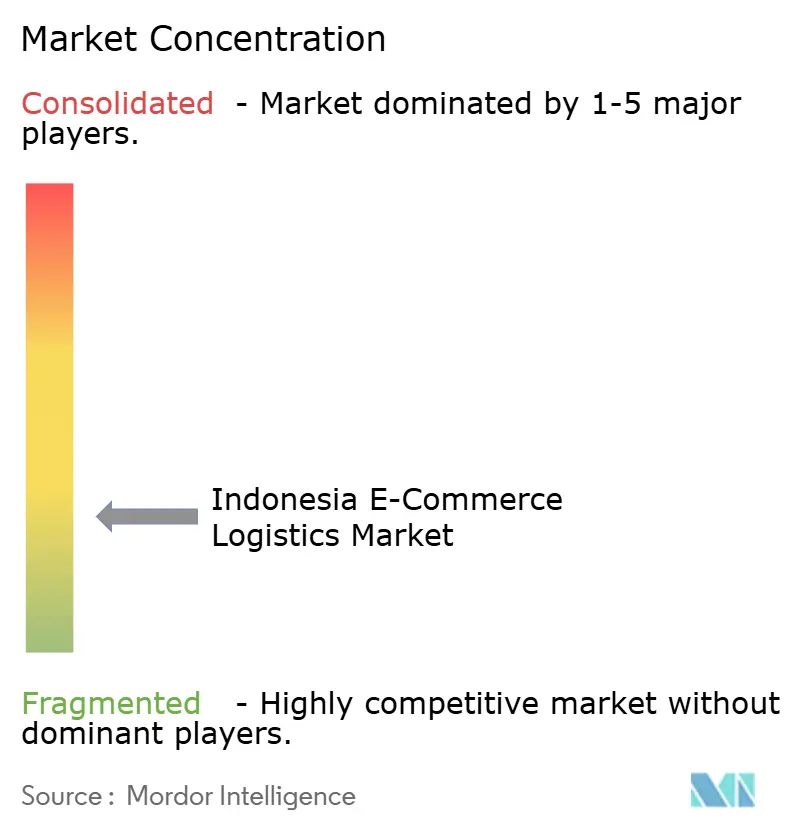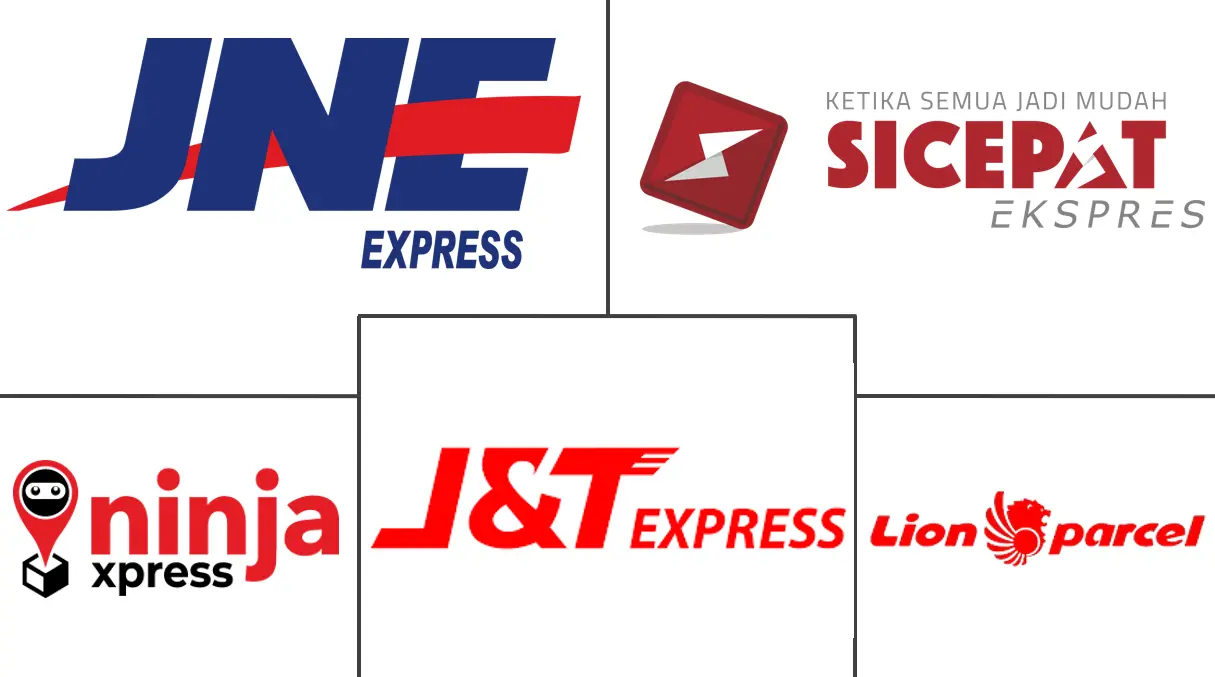Indonesia E-Commerce Logistics Market Size and Share

Indonesia E-Commerce Logistics Market Analysis by Mordor Intelligence
Indonesia E-Commerce Logistics Market size in 2026 is estimated at USD 5.71 billion, growing from 2025 value of USD 5.27 billion with 2031 projections showing USD 8.56 billion, growing at 8.42% CAGR over 2026-2031.
Digital ordering volumes climbed 35% in 2024, and government programs that connect provincial logistics hubs with national platforms continue to streamline network integration. Investments in roads, ports, and automated sortation centers shorten delivery cycles, while urban consumers push providers to accelerate same-day and next-day options. Fragmented competition keeps prices low but pressures profit margins, prompting carriers to upgrade AI-driven route planning and warehouse robotics. Meanwhile, regulatory reforms for parcels below USD 1,500 ease cross-border compliance, opening new revenue channels for small exporters.
Key Report Takeaways
- By service, transportation led with 76.35% of Indonesia e-commerce logistics market share in 2025; value-added services are expected to post a 6.98% CAGR through 2031.
- By business model, the B2C segment held 73.40% of the Indonesia e-commerce logistics market share in 2025, while B2B is projected to advance at a 6.59% CAGR to 2031.
- By destination, domestic deliveries accounted for 85.30% of the Indonesia e-commerce logistics market size in 2025, and cross-border services are set to grow at a 5.99% CAGR between 2026-2031.
- By delivery speed, standard services captured 50.25% of the Indonesia e-commerce logistics market size in 2025; same-day delivery is on track for a 6.28% CAGR through 2031.
- By product category, fashion and lifestyle commanded 21.60% share of the Indonesia e-commerce logistics market size in 2025, while grocery/FMCG is expanding at a 6.96% CAGR to 2031.
- By city tier, tier 1 locations represented 57.25% of logistics volume in 2025, and tier 2 cities are forecast to grow at a 6.66% CAGR through 2031.
- By province, West Java dominated with 16.70% share in 2025; East Java is projected to post a 5.98% CAGR during 2026-2031.
Note: Market size and forecast figures in this report are generated using Mordor Intelligence’s proprietary estimation framework, updated with the latest available data and insights as of January 2026.
Indonesia E-Commerce Logistics Market Trends and Insights
Drivers Impact Analysis
| Driver | (~) % Impact on CAGR Forecast | Geographic Relevance | Impact Timeline |
|---|---|---|---|
| Explosive parcel-volume surge from tier-2/3 cities | +2.1% | National, with concentrated gains in Central Java, East Java, and emerging urban centers | Medium term (2-4 years) |
| Government push to cut logistics cost-to-GDP to 8% | +1.8% | National, with priority implementation in Java corridor and major port cities | Long term (≥ 4 years) |
| Rapid uptake of same-day/next-day delivery options | +1.4% | Metro Jakarta, Surabaya, Bandung, with spillover to tier-2 cities | Short term (≤ 2 years) |
| Indonesia's IDR 400 trillion infrastructure investment | +1.6% | National, with emphasis on inter-island connectivity and eastern regions | Long term (≥ 4 years) |
| Infrastructure investments shrinking delivery transit times | +1.2% | Java corridor, with expansion to Sumatra and Kalimantan | Medium term (2-4 years) |
| National-capital move to Nusantara redrawing fulfillment hubs | +0.9% | East Kalimantan, with spillover effects to Java and eastern regions | Long term (≥ 4 years) |
| Source: Mordor Intelligence | |||
Explosive Parcel-Volume Surge from Tier-2/3 Cities
Improved 4G coverage and smartphone affordability are propelling online shopping outside metropolitan cores, lifting parcel counts in Semarang, Malang, and other secondary markets[1]Kementerian Komunikasi dan Informatika, “Survei Literasi Digital Indonesia 2024,” kominfo.go.id. Providers must redesign networks to serve lower-density zones cost-effectively, blending regional depots with city-level micro-fulfillment points. Quick-commerce operators such as Tokopedia Now increasingly stock multiple pick points nearby, forcing carriers to orchestrate rapid pick-pack-ship flows across a wider geography. The National Logistics Ecosystem program supplies common data rails that link provincial warehouses to national carriers, lowering onboarding barriers for smaller players.
Government Push to Cut Logistics Cost-to-GDP to 8%
Indonesia’s RPJMN 2025-2029 embeds logistics efficiency as a pillar of economic resilience[2]Bappenas, “Narasi RPJMN 2025-2029,” bappenas.go.id. Ministries coordinate road, port, and ICT upgrades to shrink empty backhauls and administrative delays. A new National Logistics Agency bill aims to centralize policy, preventing port congestion episodes such as the 2024 container backlog that stranded 26,415 boxes. Kominfo has been assigned as a neutral data integrator, incentivizing carriers to expose API feeds that enable shipment visibility and dynamic slot booking.
Rapid Uptake of Same-Day/Next-Day Delivery Options
Urban consumers increasingly value immediacy, and marketplaces answer by subsidizing express tiers that now grow at a 6.4% CAGR. Grab Express, GoSend, and Shopee Express compete on delivery windows as tight as two hours, which requires dense city nodes, AI dispatch, and high driver availability. Micro-warehouses inside Jakarta ring roads position top SKUs within 5 km of shoppers, and temperature-controlled lockers support grocery launches. Local rules mandate courier licenses and zoning clearances for urban hubs, favoring incumbents with compliance staff.
IDR 400 Trillion Infrastructure Investment
Multi-modal projects such as the Patimban Access Toll (USD 264 million) and rail links across East Java trim truck transit times, while capacity expansions at Tanjung Priok port unclog sea freight flows[3]Taiwan News, “Indonesia Logistics and Warehousing Market Forecast,” taiwannews.com.tw. Fiber-optic extensions and 5G pilots enable IoT sensors in warehouses, letting operators slice picking errors and forecast truck loading earlier. Collectively, these works raise service reliability and widen profit pools for providers willing to co-invest in automation.
Restraints Impact Analysis
| Restraint | (~) % Impact on CAGR Forecast | Geographic Relevance | Impact Timeline |
|---|---|---|---|
| Archipelagic geography inflates inter-island last-mile costs | -1.2% | National, with acute impact on eastern provinces and remote islands | Long term (≥ 4 years) |
| Fragmented CEP price war eroding provider margins | -0.8% | National, with concentration in competitive metro markets | Short term (≤ 2 years) |
| Indonesia's island geography drives up last-mile delivery costs | -1.0% | Eastern Indonesia, remote islands, and inter-island routes | Long term (≥ 4 years) |
| Skilled-labour gap in modern Grade-A warehouses | -0.7% | Major urban centers and industrial zones | Medium term (2-4 years) |
| Source: Mordor Intelligence | |||
Archipelagic Geography Inflates Inter-Island Last-Mile Costs
Serving 17,500 islands saddles carriers with extra sea legs, weather risks, and scarce return loads that push delivery costs 40-60% above Java norms[4]Kementerian Perhubungan, “Strategi Pengembangan Transportasi Laut,” dephub.go.id. Short sea shipping remains underserved due to shallow ports and overlapping maritime rules, while monsoon seasons upend schedules and inventory forecasts. The Sea Toll subsidy helps, yet commercial providers still shoulder cost premiums for reliable sailings to Maluku or Papua.
Fragmented CEP Price War Eroding Provider Margins
With dozens of parcel players, aggressive discounting dilutes returns; national truckload factors average 48%, evidencing overcapacity. Shopee’s April 2025 exit from J&T Express’s Standard Eco tier underscores how platforms can reshuffle partners to cut bills. Thin margins deter smaller firms from investing in sorting automation, perpetuating manual errors and slower turnarounds.
Segment Analysis
By Service: Transportation Holds Sway amid Rising Value-Added Needs
Transportation captured 76.35% of the Indonesia e-commerce logistics market size in 2025 as road networks carry bulk intra-Java traffic and sea freight stitches together the archipelago. Yet value-added services, led by labeling and kitting, are projected to grow 6.98% CAGR, feeding brands’ need for curated packaging. Operators increasingly embed robotic arms and RFID gates to elevate accuracy and shrink dwell times. Integrated setups that blend trucking, storage, and customization win large marketplace contracts.
Ongoing infrastructure upgrades enhance road reliability, but rising fuel prices and environmental targets nudge carriers to optimize routing and test electric vans. Warehousing demand clusters near Jakarta and Surabaya ports, prompting a surge in build-to-suit leases for automated hubs. Fulfillment players that can flex capacity around seasonal peaks, such as Singles Day or Ramadan, secure higher-margin slots with leading platforms.

Note: Segment shares of all individual segments available upon report purchase
By Business Model: B2C Dominance with B2B Upswing
B2C retained 73.40% of Indonesia e-commerce logistics market share in 2025 on the back of marketplace scale and urban customer density. Price sensitivity compels carriers to strip costs, spurring batch deliveries and crowdsourced riders for the final mile. B2B, forecast to rise 6.59% CAGR, benefits from manufacturers' digitizing procurement and demanding just-in-time replenishment. Providers targeting factory lines add inventory audit, quality checks, and vendor-managed stock to deepen client stickiness.
C2C stays niche but receives lift from social-commerce platforms that trade preloved fashion and crafts. Here, authentication and low-cost return loops differentiate service propositions. Marketplace-controlled networks could roll out hybrid models that pool B2C and B2B line-haul to boost truck utilization, compressing independent forwarders’ margins.
By Destination: Domestic Bulk with Expanding Cross-Border Edge
Domestic parcels accounted for 85.30% of total volume in 2025, reflecting Indonesia’s vast internal demand. Toll-road additions and port dredging pare transit times between Java and Sumatra, making two-day delivery feasible. Nevertheless, cross-border moves, predicted at 5.99% CAGR, accelerate as PMK 4/2025 simplifies exports under USD 1,500 and Asian buyers tap Indonesian fashion labels. Carriers offering in-house customs brokerage and multi-currency COD attract SMEs looking abroad.
International flows remain vulnerable to destination permits-BPOM for food or CE marking for electronics-spawning niche compliance consultancies. Global integrators like DHL leverage direct Hong Kong-Jakarta flights to shave hours from airfreight cycles, courting high-value electronics shippers.
By Delivery Speed: Standard Rules, Express Gains
Standard 3-5-day tiers held 50.25% of the Indonesia e-commerce logistics market size in 2025, balancing affordability and predictability. Regional sort hubs enable evening line-hauls and next-morning out-for-delivery cycles across Java’s major cities. Same-day services grow at a 6.28% CAGR concentrated in megacities; riders collect from micro-fulfillment dark stores and rely on AI dispatch to hit two-hour windows.
Next-day (24-48-hour) offerings find traction in satellite cities where distance precludes instant delivery, yet speed still commands a modest upcharge. Premium fresh-food circuits incorporate insulated totes and cold-chain vans to uphold temperature integrity. Remote islands stick with 5+-day services due to sparse flights and ferry schedules, but drone trials in Papua signal future disruption.

Note: Segment shares of all individual segments available upon report purchase
By Product Category: Fashion Tops, Grocery Accelerates
Fashion & lifestyle goods retained 21.60% of volume in 2025, fueled by influencers and flash-sale events that spike returns and require robust reverse logistics. Providers deploy size-checking kiosks at pickup points to lower exchange costs. Grocery/FMCG, the fastest-rising vertical at 6.96% CAGR, pushes cold-chain maturity; Lion Parcel invested IDR 250 billion (USD 15.4 million) in temperature-controlled fleets to tap the niche.
Electronics shipments need shock-proof packaging and frequently leverage insurance add-ons. Personal-care items benefit from subscription boxes that allow carriers to pre-plan recurring routes. Furniture sees bundled assembly services, demanding trained crews and appointment slot coordination.
By City Tier: Tier 1 Scale, Tier 2 Momentum
Tier 1 zones delivered 57.25% of volume in 2025 owing to dense populations and developed road grids. Competitive intensity drives tech adoption, such as blockchain tracking by TIKI and robotic sorters at Pos Indonesia’s Bandung hub. Tier 2 cities, charting a 6.66% CAGR, leverage new toll links and lower rental rates, allowing carriers to stage inventory closer to emerging demand.
Smart-city pilots in Semarang and Makassar install parcel lockers within transit hubs, cutting failed-delivery costs. Tier 3+ regions remain thinly served, but mobile data growth and Sea Toll subsidies inch them into e-commerce circuits. Hybrid networks combining postal vans for trunk legs and ride-hailing bikes for the final mile help tame cost curves.
Geography Analysis
West Java generated 16.70% of 2025 logistics value, supported by mature highways and industrial estates that cluster automotive, textile, and electronics plants. The Patimban Access Toll connects factories to a deep-sea port capable of handling 7 million TEUs annually. High warehouse rents near Jakarta drive operators to outer rings, trading longer last-mile distances for cheaper land.
East Java’s 5.98% CAGR outlook is fueled by manufacturing expansions in food processing and petrochemicals, plus upgraded rail and toll corridors that enable two-day coverage of eastern islands. Surabaya’s Tanjung Perak port adds berths and cranes, reducing wait times and drawing exporters from Central and East Kalimantan. Labor costs remain 15-20% below Jakarta benchmarks, enticing 3PLs to co-locate multi-client fulfillment centers.
Competitive Landscape
Indonesia's e-commerce logistics market competition remains fragmented, spurring rate battles that trim gross margins to low single digits. J&T Express, JNE, and SiCepat each handle over 1 million daily parcels yet still chase volume to amortize rising fuel and tech costs. Shopee’s April 2025 switch to J&T Cargo exemplifies marketplaces asserting leverage to renegotiate fees and service levels.
Technology investment is now the pivot point. Shipper’s collaboration with NVIDIA embeds AI predictive analytics that forecast demand spikes and recommend dynamic fleet re-balancing. Pos Indonesia’s RFID-enabled robotic sorters lifted sort capacity 40% while trimming errors. Cold-chain entrants such as Lion Parcel target grocery verticals, while Paxel’s same-day model expands to secondary cities after a USD 25 million Series B raise.
White-space exists in compliance-intensive niches—cross-border clearance, pharmaceutical logistics, and warehouse management for B2B platforms. The National Logistics Ecosystem encourages API interoperability, attracting SaaS startups that bridge order management, customs, and carrier capacity. Regulatory changes such as PMK 11/2025’s VAT flat rate require carriers to remodel billing systems quickly, favoring scale players with dedicated compliance teams.
Indonesia E-Commerce Logistics Industry Leaders
JNE Express
J&T Express
SiCepat Ekspres
Ninja Xpress
Lion Parcel
- *Disclaimer: Major Players sorted in no particular order

Recent Industry Developments
- April 2025: FedEx launched its FedEx Surround visibility suite for Indonesian shippers.
- April 2025: DSV agreed to acquire Schenker for EUR 14.3 billion (USD 14.9 billion), expanding regional capacity.
- February 2025: DHL Express added a direct Hong Kong–Jakarta freighter, shortening Asia-Pacific transit times.
- January 2024: Pos Indonesia deployed Libiao Robotics t-Sort units and RFID scanning in Surabaya for full automation.
Indonesia E-Commerce Logistics Market Report Scope
The term "e-commerce logistics" refers to the transportation, warehousing, and distribution services provided to an online retailer by the logistics company. The Indonesia eCommerce Logistics Market is segmented by service (transportation, warehousing and inventory management, and value-added services), by business (B2B and B2C), by destination (domestic and international/cross-border), and by product (fashion and apparel, consumer electronics, home appliances, furniture, beauty and personal care products, and other products). The report offers market sizes and forecasts in value (USD billion) for all the above segments.
| Transportation | Road |
| Rail | |
| Air | |
| Sea | |
| Warehousing & Fulfilment | |
| Value-Added Services (Labelling, Packaging, Kitting) |
| B2C |
| B2B |
| C2C |
| Domestic |
| Cross-border (international) |
| Same-day (less than 24 h) |
| Next-day (24–48 h) |
| Standard (3-5 days) |
| Others (more than 5 days) |
| Foods & Beverages |
| Personal & Household Care |
| Fashion & Lifestyle (accessories, apparel, footwear) |
| Furniture |
| Consumer Electronics & Household Appliances |
| Other Products |
| Tier 1 |
| Tier 2 |
| Tier 3 and Below |
| Central Java |
| East Java |
| West Java |
| Jakarta |
| Banten |
| Rest of Provinces |
| By Service | Transportation | Road |
| Rail | ||
| Air | ||
| Sea | ||
| Warehousing & Fulfilment | ||
| Value-Added Services (Labelling, Packaging, Kitting) | ||
| By Business Model | B2C | |
| B2B | ||
| C2C | ||
| By Destination | Domestic | |
| Cross-border (international) | ||
| By Delivery Speed | Same-day (less than 24 h) | |
| Next-day (24–48 h) | ||
| Standard (3-5 days) | ||
| Others (more than 5 days) | ||
| By Product Category | Foods & Beverages | |
| Personal & Household Care | ||
| Fashion & Lifestyle (accessories, apparel, footwear) | ||
| Furniture | ||
| Consumer Electronics & Household Appliances | ||
| Other Products | ||
| By City Tier | Tier 1 | |
| Tier 2 | ||
| Tier 3 and Below | ||
| By Provinces | Central Java | |
| East Java | ||
| West Java | ||
| Jakarta | ||
| Banten | ||
| Rest of Provinces |
Key Questions Answered in the Report
How large is the Indonesia e-commerce logistics market in 2026?
The Indonesia e-commerce logistics market size is valued at USD 5.71 billion in 2026 and is projected to grow at an 8.42% CAGR to 2031.
Which service segment leads Indonesian e-commerce logistics?
Transportation commands 76.35% share, driven by extensive road and sea networks serving domestic and inter-island shipments.
What is the fastest-growing delivery speed category?
Same-day delivery is expected to post a 6.28% CAGR between 2026 and 2031, reflecting rising urban consumer demand for instant fulfillment.
Which province offers the highest growth potential for logistics providers?
East Java is forecast to grow at 5.98% CAGR, leveraging Surabaya’s port upgrades and expanding manufacturing base.
How does recent regulation affect cross-border parcels?
PMK 4/2025 simplifies export-import rules for parcels under USD 1,500, reducing documentation steps and accelerating clearance for small exporters.



